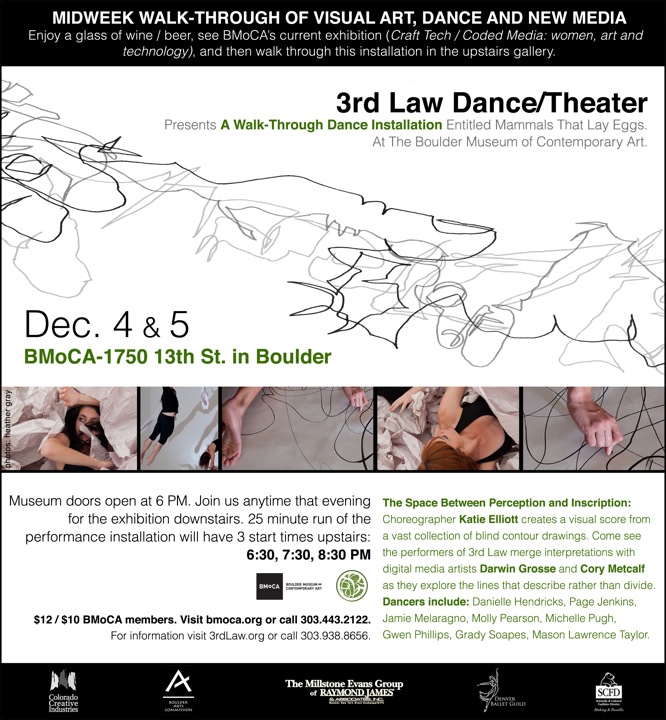3rd Law Dance/Theater’s “Mammals That Lay Eggs”
A review by Gwen Gray
“People always want to know about the title,” says 3rd Law Dance/Theater’s artistic director and choreographer Katie Elliott, with a smile. The platypus, it turns out, is invoked in 3rd Law’s latest performance — an installation at the Boulder Museum of Contemporary Art — as a metaphor representing the in-between spaces of existence: paradox, contradiction, and the mysterious places between perception, interpretation and creation.

Photo by Heather Gray
It’s just one of the many conceptual layers from which “Mammals” was born. As Elliott and co-director Jim LaVita described moments before Wednesday evening’s performance, the process of creating the work itself was also the concept.
The piece’s score was created from blind contour drawings made of hands — done by Elliott and the cast. Why blind contouring? Elliott explains that the process of drawing without looking at the page removes the judgment that can get in the way of interpretation. The company members’ separate studies were then married together into a continuous drawing, presented at the edge of the dance floor.
The continuous line became the score for the movement — one that the dancers were asked to help interpret together through collaborative choreography. Digital media artists Darwin Grosse and Cory Metcalf interpreted the drawings to create the musical accompaniment. And Elliott, at times, also used the multimedia lighting to “draw” live projections during the 30-minute performance.
A lot of context? Perhaps, but would you expect a dance company named after Newton’s Third Law of Motion to be any less cerebral? (The Boulder-based troupe won the “Cutting Edge” award from the Colorado Dance Alliance for “innovative and creative use of 21st-century artistic and technological tools in dance.”)

Photo by Heather Gray
Yet all the complex layers that formed the installation were immediately set free by the simplicity of the scene. A white floor stretched across the upper level of the BMoCA and four white walls had been erected and mitered in pairs to form two opposite corners. As the audience entered the room, eight dancers, dressed in black, were already trickling into this “in between” space, first in pairs, becoming inky embodiments of the contour drawings. The other dancers remained in the margins, moving in silhouette against the outer edges of the white corners.
Though the dancers rarely left the ground by more than a few inches — and even then were often grounded by another dancer’s touch — the movements suffered no lack of dynamism. The white floor, at one point, became an actual canvas, as two female dancers appeared with markers and, moving toward one another from opposite corners, traced the swirling lines of light projected on the floor. Another pair of females seemed to nurture one another as they embraced and danced in a few rare moments of synchronization. As the music intensified, two male dancers began a powerful negotiation with their backs to one another, moving with a tense but fluid urgency. And a male and female pair elicited a collective gasp as she, in a blink, tumbled across his back in a ball.
Eventually, the dancers all made their way back to the center of the room, standing together while vertical rays of white light sliced across their bodies. They stood shoulder to shoulder, facing the beams and moving together, until one by one, they evaded the light and trickled back out to the peripheries where the audience stood — further removing the veil between performer and audience, and connecting the line back again between creation and perception.









Trackbacks/Pingbacks
[…] Elliott and Jim LaVita are known was evident. In the opening piece, “Blind Contour,” which originally debuted as part of a Boulder Museum of Contemporary Art installation, the choreography sets out to explore […]